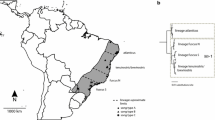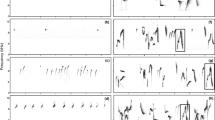Abstract
The evolution of crossbills is one of the most fascinating topics in evolutionary ecology. Recent studies have shown an astonishing divergence in terms of vocalisation between morphologically quite similar crossbill populations in the Red/Common Crossbill complex (Loxia curvirostra) of North America and Europe. Some evidence even indicates the existence of “cryptic” species with different vocal types and bill sizes, which are adapted to different conifer species. However, there is so far no strong genetic evidence for the existence of separate species, although assortative mating occurs with respect to bill size. To understand the role of vocalisation in the speciation process of crossbill taxa, basic studies that assess the distribution of vocal types of crossbills and the use of different habitats and resources are needed. In our study, we investigated the occurrence of crossbill vocal types in Southwest Europe. In addition to the well-known vocal types described first by Robb (Dutch Birding 22:61–107, 2000) for the Benelux and Great Britain, we discovered at least six more vocal types in the Mediterranean area. Some vocal types were found exclusively in rather small areas, e.g. in the Pyrenees, the Sierra de Cazorla, Sierra de Javalambre and on Corsica, and appeared to be tightly linked to certain habitat types and pine species. Overall, vocal types in the Mediterranean had a more local occurrence than vocal types from northern populations, which were more widely distributed. This might reflect the nomadic behaviour of northern European crossbills, which feed, in contrast to Mediterranean crossbills, mostly on rather unstable food sources, especially spruce seeds. Furthermore, the vocal types of Mediterranean crossbills show at least some similarities to the vocal types of the rather sedentary crossbills of North Europe (L. pytyopsittacus, L. scotica), which are as well adapted to pine seeds. This might reflect a common ancestry of crossbills adapted for pines. We therefore suggest the existence of two main groups of crossbills in Europe: one group that is rather sedentary and feeds mainly on pine seeds (L. pytyopsittacus, L. scotica and the Mediterranean forms), and another group in Central, Northern and Eastern Europe that is highly nomadic and mostly feeds on spruce seeds (L. curvirostra). Further studies are needed to unravel the consistency of vocal types and the genetic relationship between the different forms, and to provide more evidence for the degree of assortative mating of crossbills with distinct vocalisation breeding in sympatry.




Similar content being viewed by others
References
Alonso D, Arizaga J, Miranda R, Hernández MA (2006) Morphological diversification of Common Crossbill Loxia curvirostra populations within Iberia and the Balearics. Ardea 94:99–107
Benkman CW (1993) Adaptation to single resources and the evolution of crossbill (Loxia) diversity. Ecol Monogr 63:305–325
Benkman CW (1999) The selection mosaic and diversifying coevolution between crossbills and lodgepole pine. Am Nat 153(Suppl):S75–S91
Benkman CW (2003) Divergent selection causes the adaptive radiation of crossbills. Evolution 57:1176–1181
Clouet M, Joachim J (1996) Premiers élements de comparaison de trois populations françaises de beccroisés Loxia curvirostra. Alauda 64:149–155
Constantine M, The Sound Approach (2006) The sound approach to birding: a guide to understanding bird sound. The Sound Approach, Poole, UK
Cramp S, Perrins CM (1994) The birds of the Western Palearctic, vol 8. Oxford University Press, Oxford
Dickinson EC (ed) (2003) The Howard and Moore complete checklist of the birds of the world, 3rd edn. Christopher Helm, London
Eck S (1981) Reflexionen über die Taxonomie west-paläarktischer Loxia-Arten (Aves, Passeriformes, Fringillidae). Zool Abh 37:183–207
Edelaar P (2008) Assortative mating also indicates that common crossbill Loxia curvirostra vocal types are species. J Avian Biol 39:9–12
Edelaar P, Terpestra K (2004) Is the nominate subspecies of the Common crossbill polytypic? I. Morphological differences among years at a single site. Ardea 92:93–102
Edelaar P, van Eerde K, Terpestra K (2008) Is the nominate subspecies of the common crossbill Loxia c. curvirostra polytypic? II. Differentation among vocal types in functional traits. J Avian Biol 39:108–115
Förschler MI, Kalko EKV (2006) Breeding ecology and nest site selection in allopatric mainalnd citril finches and insular Corsican finches. J Ornithol 147:553–564
Förschler MI, Kalko EKV (2007) Geographic differentiation, acoustic adaptation and species boundaries in mainland citril finches and insular Corsican finches, super-species Carduelis [citrinella]. J Biogeogr 34:1591–1600
Fouarge JP (2005) Les Beccroisés. Quelle histoire! Vous avez dit. Quelle histoire? Aves 4:209–218
Génard M, Lescourret F (1987) The Common Crossbill Loxia curvirostra in the Pyrenees: some observations on its habitats and on its relations with conifer seeds. Bird Stud 34:52–63
Glutz von Blotzheim UN, Bauer KM (1997) Handbuch der Vögel Mitteleuropas, Band 14. Aula-Verlag, Wiesbaden
Groth JG (1988) Resolution of cryptic species in Appalachian Red Crossbills. Condor 90:745–760
Groth JG (1993) Evolutionary differentiation in morphology, vocalizations, and allozymes among nomadic sibling species in the North American Red Crossbill (Loxia curvirostra) complex. Univ California Publ Zool 127:1–143
Grussu M, Asuni V (2003) Nuova nidificazione di Crociere Loxia curvirostra in Sardegna. Aves Ichnusae 6(1–2):23–28
Knox AG (1975) Crossbill taxonomy. In: Nethersole-Thompson SD (ed) Pine Crossbills. Poyser, Berkhamsted, UK, pp 191–201
Knox AG (1990) The sympatric breeding of Common and Scottish Crossbills Loxia curvirsotra and L. scotica and the evolution of crossbills. Ibis 132:454–466
Massa B (1987) Variations in Mediterranean crossbills Loxia curvirostra. Bull Brit Ornith Club 107:118–29
Marquiss M, Hobson KA, Newton I (2008) Stable isotope evidence for different regional source areas of common crossbill Loxia curvirostra irruptions into Britain. J Avian Biol 39:30–34
Murray RD (1978) Crossbill evolution. Br Birds 71:318–319
Nethersole-Thompson SD (1975) Pine Crossbills. Poyser, Berkhamsted, UK
Newton I (1972) Finches. Collins, London
Newton I (2006) Movement patterns of Common Crossbills Loxia curvirostra in Europe. Ibis 148:782–788
Newton I (2008) The migration ecology of birds. Academic/Elsevier, London
Pasquet E, Thibault JC (1997) Genetical differences among mainland and insular forms in the Citril Finch Serinus citrinella. Ibis 139:679–684
Parkin DT (2003) Birding and DNA: species for the new millennium. Bird Stud 50:223–242
Parchmann TL, Benkman CW, Britch SC (2006) Patterns of genetic variation of New World crossbills (Aves: Loxia). Mol Ecol 15:1873–1887
Piertney SB, Summers RW, Marquis M (2001) Microsatellite and mitochondrial DNA homogeneity among phenotypically diverse crossbill taxa in the UK. Proc Royal Soc Lond B 268:1511–1517
Questiau S, Gielly L, Clouet M, Taberlet P (1999) Phylogeographical evidence of gene flow among Common Crossbill (Loxia curvirostra, Aves, Fringillidae) populations at the continental level. Heredity 83:196–205
Robb MS (2000) Introduction to vocalizations of crossbills in north-western Europe. Dutch Birding 22:61–107
Senar JC, Borras A, Cabrera T, Cabrera J (1993) Testing for the relationship between coniferous crop stability and common crossbill residence. J Field Ornithol 64:464–469
Smith JW, Benkman CW (2007) A coevolutionary arms race causes ecolgogical speciation in crossbills. Am Nat 169:455–465
Snowberg LK, Benkman CW (2007) The role of marker traits in the assortative mating within red crossbills, Loxia curvirostra complex. J Evol Biol 20:1924–1932
Summers J, Jardine DC (2005) Vocal similarities between Mediterranean and North European Pine crossbills Loxia spp. Ardeola 52:269–278
Summers RW, Dawson JG, Phillips RE (2007) Assortative mating and patterns of inheritance indicate that the three crossbill taxa in Scotland are species. J Avian Biol 38:153–162
Tyrberg T (1991) Crossbill (genus Loxia) evolution in the west Palearctic–a look at the fossil evidence. Ornis Svecica 1:3–10
Zink G, Bairlein F (1995) Der Zug europäischer Singvögel. Ein Atlas der Wiederfunde beringter Vögel. Band III. Fringillidae. Aula-Verlag, Wiesbaden
Acknowledgments
We thank Esther del Val, Alexander Tahori, Erich Weber and two anonymous referees for constructive comments on our manuscript. The study was conducted with financial support from the Max Planck Research Centre for Ornithology (Vogelwarte Radolfzell), the Landesgraduiertenförderung Baden-Württemberg, University of Ulm, to M. Förschler, and a fellowship within the Postdoc-Programme of the German Academic Exchange Service (DAAD). Hans Heiner Bergmann kindly provided some additional recordings of crossbill flight calls from Austria.
Author information
Authors and Affiliations
Corresponding author
Additional information
Communicated by F. Bairlein.
Rights and permissions
About this article
Cite this article
Förschler, M.I., Kalko, E.K.V. Vocal types in crossbill populations (Loxia spp.) of Southwest Europe. J Ornithol 150, 17–27 (2009). https://doi.org/10.1007/s10336-008-0312-z
Received:
Revised:
Accepted:
Published:
Issue Date:
DOI: https://doi.org/10.1007/s10336-008-0312-z




